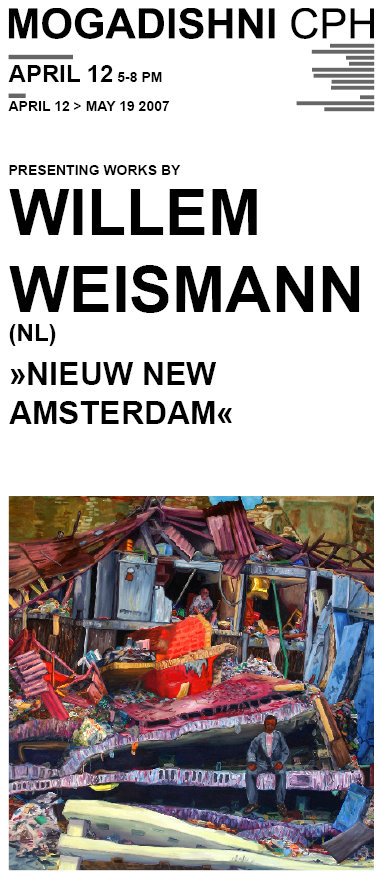Willem Weismann
dal 11/4/2007 al 18/5/2007
Segnalato da
11/4/2007
Willem Weismann
Mogadishni Cph, Copenhagen
Nieuw New Amsterdam. The show figures new paintings in his significantly detailed and highly coloristic style where both destructed and rebuilt spaces intertwine. The viewer is invited on an anthropological and sociological journey in time and space.

Nieuw New Amsterdam
Mogadishni CPH is proud to present the second solo exhibition in the gallery by the Dutch artist Willem Weismann who is based in London. The show figures new paintings in Weismann’s significantly detailed and highly coloristic style where both destructed and rebuilt spaces intertwine. In “Nieuw New Amsterdam” the viewer is invited on an anthropological and sociological journey in time and space, where sophisticated references to the colonies of the past, the cities of the present, and the eternal transit-position of the immigrant lie abundant.
In Weismann’s detailed, richly colored large scale paintings he portrays a movement away from “the old World Order” and away from the big city and towards a new way of living. A focus on individuality and the need for creating one’s own space far from modern civilization is a reappearing topic for Weismann, who often gives an insight in alternative ways of living like in tents and huts. “The tent-condition” which seems unstable at first glance can be viewed as a temporary transit-home as well as a significant proof of the human ability to re-establish. In Weismann’s construction of alternative modes of living lies an inherent comment on the conformity of modern life and the resulting lack of individual opportunity and independence. The tents and the huts are not perfect constructions - on the contrary, they reflect the person who made them. In Weismann’s works “progress” and happiness of the present are never two sides of the same matter, and he suggests that maybe happiness lies a totally different place than what this so called progress postulates.
The portrait series ”Nieuw New Amsterdam” shows a group of leaders of fictional colonies, who, portrait by portrait, gradually transforms from classical European explorers into the natives they have conquered. This transformation of the ’original’ “European-ness” to the eclectic unfolds the idea, that it can be possible to unite old enemies, that borders can be erased, and also the idea of - and the belief in a global village where different people are able to live side by side.
In Weismann paintings you often see an enormous accumulation of materials, such as old clothes, empty bottles, cans etc. which brings an immediate chaos. On closer inspection humans are able to organize themselves in the middle of this chaos and create a contemporary home and a new way of living in an environment where this would seem impossible. A new life often drags the remains of an earlier life along perhaps as a kind of comfort or perhaps as an unnecessary burden. As in the painting “Je Maintiendrai” where the journey towards the unknown and different seems slow because a raft filled with things from the past is dragged along. The question is why this enormous amount of luggage is so essential when the traveler is on the way to something new. Garbage and waste piles accumulates in Weismann’s paintings as a sign of both mental and physical remains of humans or as signs of the overload of pictures and information so typical of modern life. All the accumulated is attempted enclosed like a miniature part of life, something society stores which is hard to get rid of - and which might hold a value after all.
The painting “The Quiet Earth” shows hopelessness and hope depicted simultaneously. The physical framework of the house has been destroyed, but in spite of that a green tent has been erected in the middle of chaos, maybe as a last attempt to stay and adapt to the conditions. Weismann’s pictorial universe is filled with existential tales of the human ability to survive, hope and the desire for change and for the journey towards the unknown. Weismann poses relevant questions to history and the development of society as well as the postulated stable identity of the individual, hereby forcing the spectator to reflect and wonder.
Willem Weismann will participate in the group show "The Contented Heart" at W139, Warmoesstraat 139, 1012 JB, in Amsterdam, the Netherlands. The show will run from April 28th to June 3rd 2007. Mogadishni CPH looks forward to see you at the opening reception Thursday April 12. at 5-8 PM. The artist will be present.
Opening reception Thursday April 12. at 5-8 PM
Mogadishni CPH
Carl Jacobsensvej 16 - Copenhagen
Opening hours: Tuesday-Friday 11 AM - 5 PM/ Saturday 12 – 3 PM
Free admission



